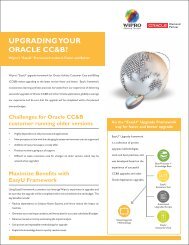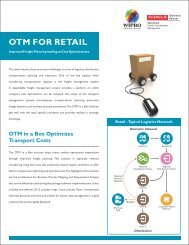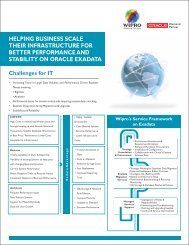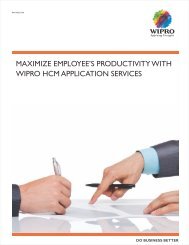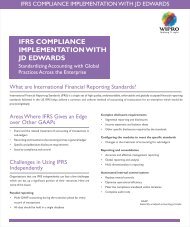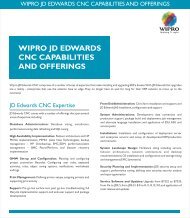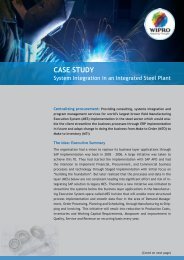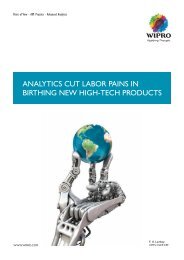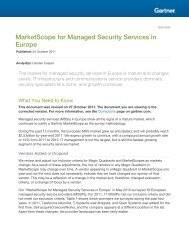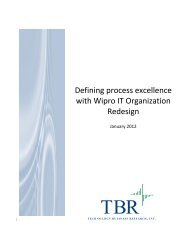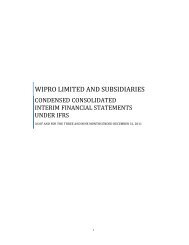Applying Change Management Practices in Government - Wipro
Applying Change Management Practices in Government - Wipro
Applying Change Management Practices in Government - Wipro
You also want an ePaper? Increase the reach of your titles
YUMPU automatically turns print PDFs into web optimized ePapers that Google loves.
A CASE STUDY<br />
The historical charter of this organization was offer<strong>in</strong>g social security and health services to a<br />
specific category of beneficiaries. It was a department with a social objective with an extended<br />
customer base stretch<strong>in</strong>g to 50 million citizens; the organization had a long history, which was<br />
managed by career bureaucrats and had a legally mandated mission.<br />
This department was fac<strong>in</strong>g tremendous challenges <strong>in</strong> achiev<strong>in</strong>g transparent and efficient process <strong>in</strong><br />
delivery of citizen service; compla<strong>in</strong>ts of poor customer service, procedural delays and rigidity were<br />
common. An IT solution was adopted by this Department to meet the need for speed, transparency<br />
and accuracy. The IT revolution brought functional changes which impacted employees both at the<br />
personal and the organizational levels.<br />
As the department focused on f<strong>in</strong>d<strong>in</strong>g and implement<strong>in</strong>g the solutions best suited to their needs,<br />
deployment, <strong>in</strong>tegration, <strong>in</strong>frastructure issues became a priority over and above the pressure created<br />
on the employee who had to learn and adapt to the new ethos. From an employee's standpo<strong>in</strong>t there<br />
were several reasons to be resistant to this change. One, In <strong>Government</strong> setups, the schemes or the<br />
projects are mandated at either the federal or the central level and these decision makers are<br />
generally away from the day- to -day function<strong>in</strong>g of the employee. As a consequence, this became the<br />
first po<strong>in</strong>t of resistance, where the senior management at the state level did not approve of the<br />
scheme.<br />
The middle management was <strong>in</strong>formed of the approach<strong>in</strong>g change through a circular or notice ask<strong>in</strong>g<br />
them to do the needful, hence lack<strong>in</strong>g the clarity of action /purpose thereby creat<strong>in</strong>g the second layer<br />
of resistance. Three, the <strong>in</strong>formation spread further down the ranks <strong>in</strong> a diluted and unspecified<br />
manner over-the-tea sessions and the ‘afternoon walk discussions which created the image of change<br />
as an impend<strong>in</strong>g threat to the employees function and job security. The third po<strong>in</strong>t of resistance<br />
was most complicated and the employees were backed by a strong union and <strong>in</strong>terest groups. A<br />
situation was created where the project was also challenged.<br />
The organization's executive board decided that the best way to tackle resistance was to roll out a<br />
comprehensive change management <strong>in</strong>tervention program. The roll-out was delivered by a dedicated<br />
team of facilitators and <strong>Change</strong> <strong>Management</strong> experts from <strong>Wipro</strong> Consult<strong>in</strong>g Services (WCS) To lend<br />
a positive, non threaten<strong>in</strong>g image to the workshops WCS designed and created a forum called<br />
'Element’ - A Forum for Leaders and Mentors. This helped <strong>in</strong> address<strong>in</strong>g employee resistance as<br />
they felt <strong>in</strong>volved <strong>in</strong> the change. The outcomes of the workshops were frequently shared with the<br />
organization's senior management. An effective knowledge shar<strong>in</strong>g tool was put <strong>in</strong> place to be a<br />
responsive and pro-active system to <strong>in</strong>tegrate the action plan emerg<strong>in</strong>g from the workshops. In<br />
summary, the participants -<br />
- recognized the importance and essential role that New IT Project plays <strong>in</strong> the development and<br />
reforms <strong>in</strong> service delivery<br />
- recognized the importance of align<strong>in</strong>g government orders and policies <strong>in</strong> the <strong>in</strong>tegration process<br />
- appreciated the need to make the details of the new IT Project better known to external employers<br />
and workers who subscribed to the organization's mission<br />
Dur<strong>in</strong>g the workshops a pre- and post-stakeholder diagnostic study was conducted through<br />
structured questionnaires. The objective was to assess the change <strong>in</strong> levels of project awareness,<br />
project preparedness, and no fear of technology and most significantly, change <strong>in</strong> attitude. The<br />
overall analysis at the end <strong>in</strong>dicates that those <strong>in</strong>volved <strong>in</strong> the project not only knew more about<br />
what the project is, the importance of it, but they were able to see the significance of their role <strong>in</strong> it,<br />
and were better prepared for the change to come. By the end of the change management workshops,<br />
the overall progress was as follows:<br />
4




